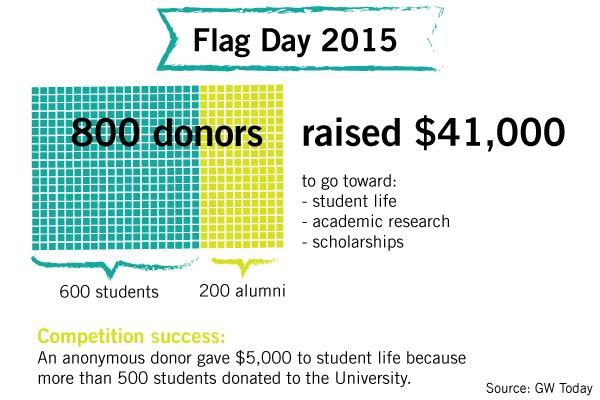A slew of GW’s latest donors are still earning their degrees.
The University held its first “Flag Day” this week, a two-day fundraising blitz aimed at bringing in donations from current students and young alumni. It marked the latest push in a series of fundraising efforts this year — but was the first ever highly public appeal to ask students from all grades to give while still paying tuition.
The event raised about $40,000 that came from more than 600 current students and 200 alumni.
Because more than 500 students made donations, an anonymous donor contributed an additional $5,000 to student life causes such as mental health resources and campus events. A group of donors, including members of the GW Parents Campaign Philanthropy Board, also matched donations that young alumni gave dollar-for-dollar on Thursday.
Members of the student life office organized events Wednesday and Thursday at campus hubs like University Yard and Kogan Plaza to fundraise, stationing students and administrators around the neighborhood to publicize the event.
Students were invited to write thank-you notes to alumni donors, take photos in a photo booth with mascot GW George and mingle with University President Steven Knapp and other officials. Throughout the week, buildings on campus were adorned with “Commander-in-Chief” flags – a way for passersby to know that their construction was made possible by alumni donations.
Steve Frenkil, the president of the GW Alumni Association, said in an email that Flag Day was a “successful and enjoyable event.”
“It is another good example of the many ways that the GW Community supports each other, and of Colonials helping Colonials,” Frenkil said.
Rachel Azarow, who graduated from GW in 2012 with a degree in English, said she wanted to give to the University during Flag Day to maximize her donation. She tends to make contributions on days when GW is running a donation campaign.
“I like to help their numbers on those days,” Azarow said. “I think it’s significant.”
The donations are pointed at specific parts of the University, so Azarow chose to give to the student-run ambulance service EMeRG because of their high operating costs, she said.
Arthur Criscillis, a managing partner at the fundraising firm Alexander-Haas, said asking students for donations is not new in higher education. He added that such campaigns are less about raking in serious gifts and more aimed at getting students to think of the University as a philanthropic cause, which they could contribute to later in life.
GW has asked current students to donate to the school since the 1980s through the Senior Class Gift campaign. Last year, the program raised $86,000 from more than half of the senior class.
But getting students into a pattern of giving earlier on has been a cornerstone of the campaign because it will likely translate into upping GW’s alumni donor rate. Historically, about 10 percent of alumni give annually, a lower rate than those of GW’s peer schools.
Criscillis said student fundraising campaigns do not typically look to raise large amounts.
“You’re not going to run a campaign among the students to establish an endowed professorship,” Criscillis said. “Everybody has to be cognizant that people don’t really have the assets or the income to be able to provide large gifts.”
Since a public launch last summer, the University’s has already brought in more than $700 million for its $1 billion campaign.
Criscillis said the students’ donations make a small impact when considered in the larger context of a fundraising campaign.
“It’s not like in the grand scheme of a billion dollar campaign that the gifts of the students are going to, you know, help that campaign as a whole to take a giant leap forward,” he said.
Ryan Lasker contributed reporting.







